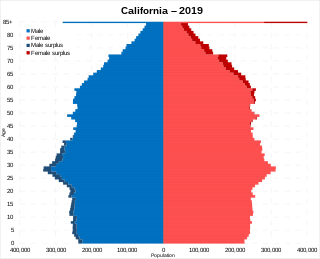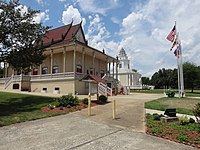
Asian Americans are Americans of Asian ancestry. Although this term had historically been used for all the indigenous peoples of the continent of Asia, the usage of the term "Asian" by the United States Census Bureau only includes people with origins or ancestry from the Far East, Southeast Asia, and the Indian subcontinent and excludes people with ethnic origins in certain parts of Asia, including West Asia who are now categorized as Middle Eastern Americans. Furthermore, Central Asians are not mentioned in any census racial category. The "Asian" census category includes people who indicate their race(s) on the census as "Asian" or reported entries such as "Chinese, Indian, Bangladeshi, Filipino, Vietnamese, Indonesian, Korean, Japanese, Pakistani, Malaysian, and Other Asian". In 2020, Americans who identified as Asian alone (19,886,049) or in combination with other races (4,114,949) made up 7.2% of the U.S. population.
An Amerasian may refer to a person born in Asia to an Asian mother and a U.S. military father. Other terms used include War babies or G.I. babies. Other persons of such ancestry may have mothers in the U.S. military or have Amerasian ancestry through their grandparents, and so on.

Chinatowns in Asia are widespread with a large concentration of overseas Chinese in East Asia and Southeast Asia and ethnic Chinese whose ancestors came from southern China—particularly the provinces of Guangdong, Fujian, and Hainan—and settled in countries such as Brunei, Cambodia, East Timor, Indonesia, India, Laos, Malaysia, Myanmar, the Philippines, Singapore, Sri Lanka, Thailand, Vietnam, Japan and Korea centuries ago—starting as early as the Tang dynasty, but mostly notably in the 17th through the 19th centuries, and well into the 20th century. Today the Chinese diaspora in Asia is primarily concentrated in Southeast Asia; however, the legacy of the once widespread overseas Chinese communities in Asia is evident in the many Chinatowns found across East, South and Southeast Asia.

In non-Asian countries, an Asian supermarket largely describes a category of grocery stores that focuses and stocks items and products imported from countries located in the Far East.

Afro-Asians, African Asians, Blasians or simply Black Asians are people of mixed Asian and African ancestry. Historically, Afro-Asian populations have been marginalised as a result of human migration and social conflict.
Asia is the largest and most populous continent and the birthplace of many religions including Buddhism, Christianity, Confucianism, Hinduism, Islam, Jainism, Judaism, Shinto, Sikhism, Taoism and Zoroastrianism. All major religious traditions are practiced in the region and new forms are constantly emerging. Asia is noted for its diversity of culture.

California is the most populated U.S. state, with an estimated population of 38.9 million as of 2023. It has people from a wide variety of ethnic, racial, national, and religious backgrounds.

Asian Canadians are Canadians who were either born in or can trace their ancestry to the continent of Asia. Canadians with Asian ancestry comprise both the largest and fastest growing group in Canada, after European Canadians, forming approximately 20.2 percent of the Canadian population as of 2021. Most Asian Canadians are concentrated in the urban areas of Southern Ontario, Southwestern British Columbia, Central Alberta, and other large Canadian cities.

The demographics of Asian Americans describe a heterogeneous group of people in the United States who trace their ancestry to one or more Asian countries.
Asian people are the people of Asia. The term may also refer to their descendants. According to the Merriam-Webster dictionary, an Asian is “a person of Asian descent”.

Asian/Pacific American (APA) or Asian/Pacific Islander (API) or Asian American and Pacific Islanders (AAPI) or Asian American and Native Hawaiians/Pacific Islander (AANHPI) is a term sometimes used in the United States when including both Asian and Pacific Islander Americans.
Asian Americans represent a growing share of the national population and of the electorate. The lower political participation of Asian Americans has been raised as a concern, especially as it relates to their influence on politics in the United States. In the 21st century, Asian Americans have become a key Democratic Party constituency.

The demographics of Filipino Americans describe a heterogeneous group of people in the United States who trace their ancestry to the Philippines. As of the 2020 Census, there were 4.4 million Filipino Americans, including Multiracial Americans who were part Filipino living in the US. Filipino Americans constitute the third-largest population of Asian Americans, and the largest population of Overseas Filipinos.

There have been a variety of ethnic groups in Baltimore, Maryland and its surrounding area for 12,000 years. Prior to European colonization, various Native American nations have lived in the Baltimore area for nearly 3 millennia, with the earliest known Native inhabitants dating to the 10th millennium BCE. Following Baltimore's foundation as a subdivision of the Province of Maryland by British colonial authorities in 1661, the city became home to numerous European settlers and immigrants and their African slaves. Since the first English settlers arrived, substantial immigration from all over Europe, the presence of a deeply rooted community of free black people that was the largest in the pre-Civil War United States, out-migration of African-Americans from the Deep South, out-migration of White Southerners from Appalachia, out-migration of Native Americans from the Southeast such as the Lumbee and the Cherokee, and new waves of more recent immigrants from Latin America, the Caribbean, Asia and Africa have added layers of complexity to the workforce and culture of Baltimore, as well as the religious and ethnic fabric of the city. Baltimore's culture has been described as "the blending of Southern culture and [African-American] migration, Northern industry, and the influx of European immigrants—first mixing at the port and its neighborhoods...Baltimore’s character, it’s uniqueness, the dialect, all of it, is a kind of amalgamation of these very different things coming together—with a little Appalachia thrown in...It’s all threaded through these neighborhoods", according to the American studies academic Mary Rizzo.
Asian Californians are residents of the state of California who are of Asian ancestry. California has the largest Asian American population in the U.S., and second highest proportion of Asian American residents, after Hawaii. As of the 2020 U.S. Census, there were over 6 million Asian-Americans in California; 15.5% of the state's population. If including those with partial Asian ancestry, this figure is around 17%. This is a jump from 13.8% recorded in 2010.
Asian Washingtonians are residents of the state of Washington who are of Asian ancestry. As of the 2010 U.S. Census, Asian-Americans were 7.7% of the state's population. As per the 2019 it’s 9-10%.

Houston has large populations of immigrants from Asia. In addition, the city has the largest Vietnamese American population in Texas and third-largest in the United States as of 2004. Houston also has one of the largest Chinese American, Pakistani American, and Filipino American populations in the United States.
Asian Virginians make up 7% of Virginia's population, and up to at least 7.5% including those considered partially Asian. The population is at least 500,000. The largest Asian groups in Virginia are mainly Indians, Chinese, Filipinos, Koreans, and Vietnamese. The state has the 8th highest percentage of Asian residents according to the 2010 Census, and is culturally connected and rooted with its Asian community.












